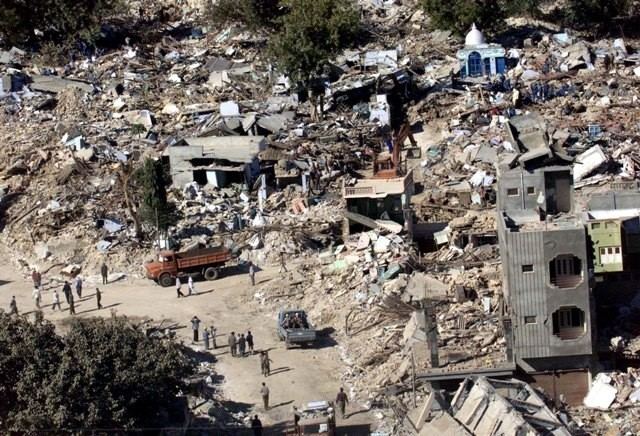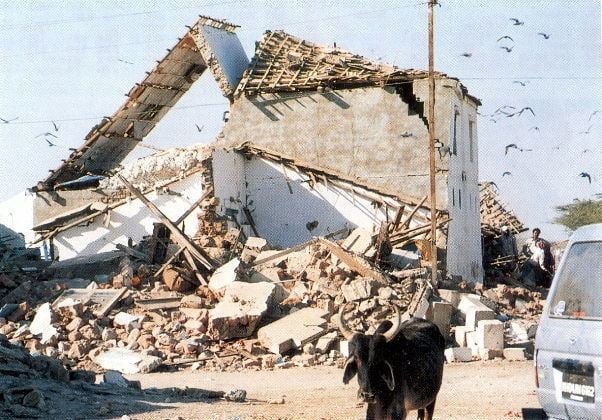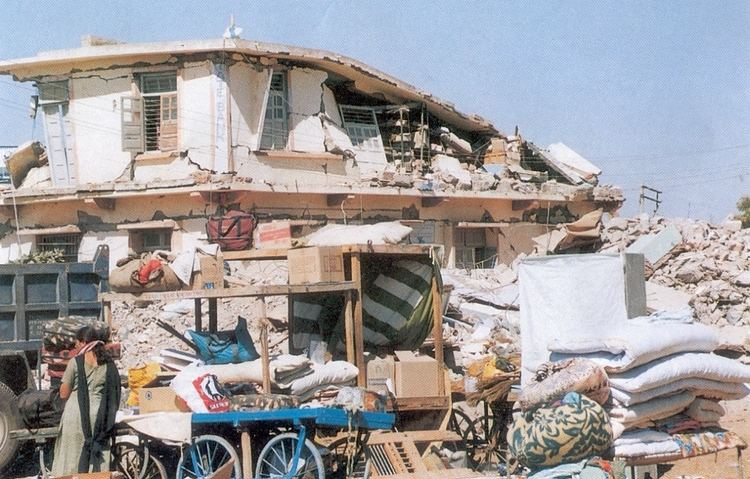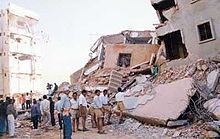Type Oblique-slip Max. intensity X (Extreme) Date 26 January 2001 | Depth 16,000 m | |
 | ||
Casualties 13,805–20,023 dead~ 166,800 injured Similar 1993 Latur earthquake, 2005 Kashmir earthquake, 1997 Jabalpur earthquake, January 2001 El Salvador, 2001 Nisqually earthquake | ||
2001 gujarat earthquake study
The 2001 Gujarat earthquake, also known as the Bhuj earthquake, occurred on 26 January, India's 52nd Republic Day, at 08:46 AM IST and lasted for over 2 minutes. The epicentre was about 9 km south-southwest of the village of Chobari in Bhachau Taluka of Kutch District of Gujarat, India.
Contents
- 2001 gujarat earthquake study
- Tectonic setting
- Effects
- Reconstruction
- Housing
- City planning
- Relief
- Memorial
- References

The intraplate earthquake reached 7.7 on the moment magnitude scale and had a maximum felt intensity of X (Extreme) on the Mercalli intensity scale. The earthquake killed between 13,805 and 20,023 people (including 18 in southeastern Pakistan), injured another 167,000 and destroyed nearly 400,000 homes.

Tectonic setting

Gujarat lies 300–400 km from the plate boundary between the Indian Plate and the Eurasian Plate, but the current tectonics are still governed by the effects of the continuing continental collision along this boundary. During the break-up of Gondwana in the Jurassic, this area was affected by rifting with a roughly west-east trend. During the collision with Eurasia the area has undergone shortening, involving both reactivation of the original rift faults and development of new low-angle thrust faults. The related folding has formed a series of ranges, particularly in central Kutch.

The focal mechanism of most earthquakes is consistent with reverse faulting on reactivated rift faults. The pattern of uplift and subsidence associated with the 1819 Rann of Kutch earthquake is consistent with reactivation of such a fault.

The 2001 Gujarat earthquake was caused by movement on a previously unknown south-dipping fault, trending parallel to the inferred rift structures.
Effects

The death toll in the Kutch region was 12,300. Bhuj, which was situated only 20 km away from the epicenter, was devastated. Considerable damage also occurred in Bhachau and Anjar with hundreds of villages flattened in Taluka of Anjar, Bhuj and Bhachau. Over a million structures were damaged or destroyed, including many historic buildings and tourist attractions. The quake destroyed around 40% of homes, eight schools, two hospitals and 4 km of road in Bhuj, and partly destroyed the city's historic Swaminarayan temple and historic fort as well Prag Mahal and Aina Mahal.
In Ahmedabad, Gujarat's commercial capital with a population of 5.6 million, as many as 50 multi-story buildings collapsed and several hundred people were killed. Total property damage was estimated at $5.5 billion and rising. In Kutch, the earthquake destroyed about 60% of food and water supplies and around 258,000 houses–90% of the district's housing stock. The biggest setback was the total demolition of the Bhuj Civil hospital. The Indian military provided emergency support which was later augmented by the International Federation of Red Cross and Red Crescent Society. A temporary Red Cross hospital remained in Bhuj to provide care while a replacement hospital was built.
Reconstruction
Four months after the earthquake the Gujarat government announced the Gujarat Earthquake Reconstruction and Rehabilitation Policy. The policy proposed a different approach to urban and rural construction with the estimated cost of rebuilding to be US$1.77 billion.
The main objectives of the policy included repairing, building, and strengthening houses and public buildings. Other objectives included the revival of the economy, health support, and reconstruction of the community and social infrastructure.
Housing
The housing policy focused on the removal of rubble, setting up temporary shelters, full reconstruction of damaged houses, and the retrofitting of undamaged units. The policy established a community-driven housing recovery process. The communities affected by the earthquake were given the option for complete or partial relocation to in-situ reconstruction. The total number of eligible houses to be repaired was 929,682 and the total number of eligible houses to be reconstructed was 213,685. By 2003, 882,896 (94%) houses were repaired and 113,271 (53%) were reconstructed.
City planning
The Environmental Planning Collaborative (EPC) was commissioned to provide a new city plan for the city of Bhuj. The plan focused on creating a wider roadway network to provide emergency access to the city. The EPC used land readjustment (LR) in the form of eight town planning schemes. This was implemented by deducting land from private lot sizes to create adequate public land for the widening of roadways. The remaining land was readjusted and given back to the original owners as final plots.
Relief
In order to support the reconstruction and rehabilitation of the city, the Government of Gujarat created four assistance packages worth up to US$1 billion. These packages assisted about 300,000 families. Also, the government announced a US$2.5 million package to revive small, medium, and cottage industries. The World Bank and the Asian Development Bank also provided loans worth $300 million and $500 million respectively.
Assistance was received from many countries and private companies.
Memorial
Smritivan, a memorial park and museum dedicated to victims of the earthquake was built atop Bhujia Hill. Total 13,805 trees dedicated to each victim were planted in the garden and 108 small water reservoirs were created on the hill.
